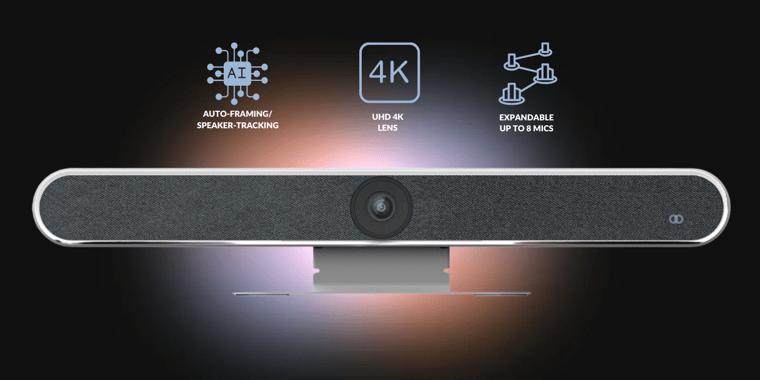
Co-founder Holli Hulett, puts powerful camera technology in focus.
- What kind of intelligent cameras (or 'smart' cameras) are available today? And in what ways are they 'intelligent', what can they do?
Smart cameras are evolving rapidly, and we're seeing major advancements across different categories, from ePTZ cameras and videobars to high-performance webcams. Today’s intelligent cameras can do much more than just capture video—they can track faces and movement, isolate specific zones, and even follow voices to ensure the right person is always in focus.
We’re also seeing exciting developments in gesture and voice control, which are actively being explored in our R&D labs. Enhanced facial recognition is another area of innovation, offering smarter automation and more seamless user experiences. The goal is to make video collaboration as effortless and immersive as possible, and we’re constantly pushing the boundaries to get there.
- How do intelligent cameras work, what goes on under the bonnet?
Intelligent cameras are becoming more powerful. In many ways this comes down to the chipsets and ‘brain’ of the hardware. But equally it has to be combined with an excellent quality lens and camera motor so the device can find and follow faces, smoothly and quickly.
- What are the core features of an intelligent camera, what should be on a buyer's shopping list if they want a camera that fully meets their needs?
The core features of an intelligent camera are to enhance the overall experience with less work from an operator. Let the camera do more of the work to minimize manual operation. It’s not just about the intelligence but a combination of other factors such as the lens, motor, and multiple connectivity options that can easily be integrated into different operating platforms, whatever they maybe. More powerful chipset algorithms as part of a high performance design, will optimize the user experience and lead to more natural engagement.
- And what special features or optional extras are available?
In many scenarios, a single camera isn’t enough. Whether it's a town hall meeting, a live cooking class, or healthcare training, capturing multiple angles and perspectives can be essential – especially when audience interaction or subject participation is involved.
Our GOJO multi-camera controller is a great solution for managing multiple devices seamlessly. Beyond cameras, there are other key factors to consider: ceiling-mounted microphones for optimized audio, streaming and recording devices for content distribution, and even mounting solutions to ensure the best possible setup. Cameras are becoming smarter, but how they’re implemented and integrated makes all the difference in delivering a seamless experience.
- How are intelligent cameras used, what and where are the principal applications?
Intelligent cameras are being used across multiple locations. Court rooms, universities, town halls, surgical theatres and live presentations. More and more dynamic uses are being delivered. For example we have a client in Mexico using a couple of MAGNA cameras in his car showroom so customers can view vehicles from the comfort of their own homes, and zoom in on specific features etc. Similarly we have several teaching hospitals live streaming surgeries to medical students using a Boom multi-camera setup.
- Is the technology as well known as it should be, or are potential customers (and their AV integrators?) still unaware of its potential?
For me it’s a mixed picture out there. Awareness and use of intelligent cameras is growing but it’s not universal. There’s still a knowledge gap. But huge consumer brands such as Apple and Samsung are now pushing and integrating AI across their technology platforms which is accelerating user confidence and elevating expectations. It’s becoming more than just a buzzword and opening people’s minds about the power of what can be achieved to improve day-to-day life.
- What kind if infrastructure/ancillary devices do intelligent cameras need? How does this differ from 'dumb' cameras?
At their core, intelligent cameras require the same fundamental infrastructure as traditional ‘dumb’ cameras – power and bandwidth. However, what sets them apart is how they leverage that infrastructure to deliver a smarter, more seamless user experience.
Unlike basic cameras that rely on external systems for processing, intelligent cameras often feature built-in AI capabilities, automatic framing, and tracking, reducing the need for manual adjustments or additional hardware like joystick controllers. That said, organisations should consider how these cameras fit into their broader AV ecosystem. For some, an all-in-one videobar may provide a streamlined, plug-and-play solution, while others with more complex requirements might benefit from a dedicated PTZ camera with advanced control options.
Ultimately, the goal is simplicity and connectivity – ensuring any device works on any platform in any space without unnecessary complexity for the user.
- What are the drawbacks of intelligent cameras, and how are these being addressed?
I think there’s often a danger that technology can have too many features that make it too complicated to use, which puts people off. Intelligent cameras still have their limitations and can’t do everything. Understanding where their sweet spot is, can limit over expectations.
- How are intelligent cameras being developed, and what will be the future trends in this technology?
There’s no doubt intelligent cameras will become even more intelligent as chipsets and algorithms develop. Voice, gesture control and actual people recognition with individual names is almost here now. Existing features such as auto framing will become more advanced too. Augmented reality and cool virtual productions will take things to a completely new level with more tailored and seamless output for specific purposes, embedded into hardware too.



